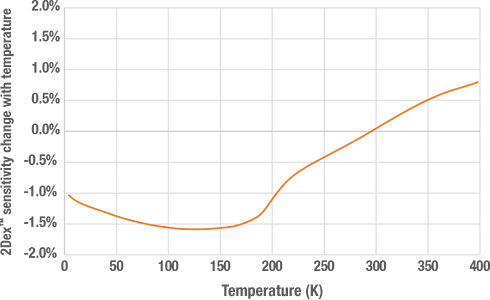Measure confidently
Smaller active areas
FP Series probes feature Hall sensors with significantly smaller active areas than in previous generation products. This results in improved spatial resolution and reduced signal averaging, useful when measuring fields close to a source where field gradients can be extreme.
High-speed measurement capability
Several options are available to capture transient magnetic fields such as magnetizer pulses or high-speed field mapping. The balance between accuracy and speed can be a challenging choice to make, but the teslameter does its best to make that choice easy to understand:
Best accuracy
A buffered data stream using the various digital interfaces (USB, Ethernet, Wi-Fi). Buffering allows the user to request data in bursts and recombine the data with a perfectly consistent time step. The teslameter stores all unrequested measurements until the next burst is requested. This measurement mode allows up to 100 readings to be captured per second (10 ms interval spacing) without having to flood the instrument with individual measurement requests. Application note: Fast magnetic field mapping with F Series teslameters.
Higher speed
The corrected analog out creates an analog representation of the reported magnetic field value with an update rate of 2,000 readings per second (500 µs time steps). This voltage is generated from the fully corrected and compensated magnetic field value and can even be set to be derived from the vector magnitude value of a 3-axis measurement. The loss in accuracy comes from the conversion from digital to analog in the teslameter and then back to digital in whichever analog measurement solution is used to capture the signal.
Highest speed
A directly amplified signal from the Hall probe or sensor. This analog out voltage lacks any of the measurement correction present in other configurations, but does have the advantage of bypassing any of the delay introduced by digitization.
Better 3-axis measurements
Our 3-axis magnetic sensors have been designed to maximize orthogonality between x, y, and z sensor elements, resulting in more accurate vector magnitude measurements when field direction is unknown or changing.
Other sources of measurement error like the planar Hall effect have also been minimized or eliminated to ensure that large off-axis fields are reported correctly. See the Planar Hall Effect Investigation in Cryogenic Environment case study for more information on the improvement over previous generation sensors.
Temperature compensation
Hall effect sensors have several characteristics that vary with temperature, resulting in Hall voltage levels that can change slightly with temperature changes. The sensors used in FP Series probes are inherently stable with temperature, however, this can be improved further with active temperature compensation.
An integrated temperature sensor at the tip of every probe relays temperature data to the teslameter. These readings are used to determine temperature offsets and compensate for them over the standard workplace ambient temperature ranges.
Cryogenic environments
Building on Lake Shore's experience in cryogenic temperature measurement, integrating these teslameters into a cryogenic system has never been easier or more accurate:
- Cryogenic operating mode on the teslameter—dropping power dissipation in the sensor by a factor of 100 to below 50 µW
- Temperature compensation of field measurements over a range of temperatures, even to cryogenic temperatures, through integration with the cryogenic system temperature controller
- Cryogenic-rated probes and sensors







